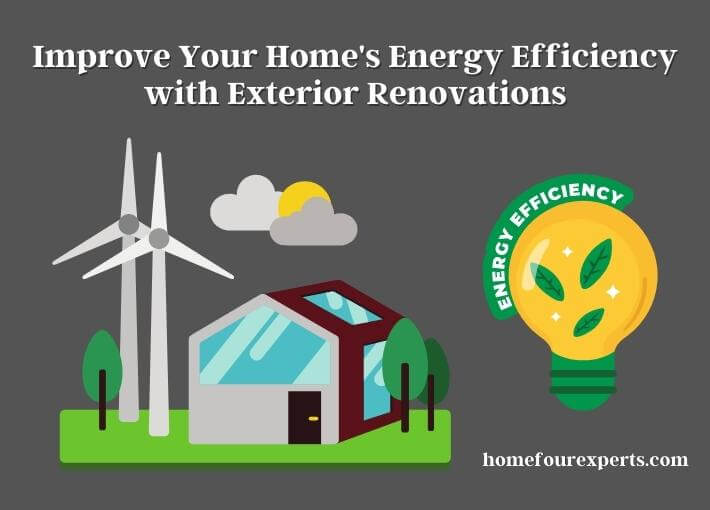Welcome to this article! In today’s world, it’s becoming increasingly important to live a sustainable lifestyle and reduce our carbon footprint. One way to achieve this is by improving the energy efficiency of our homes. Energy-efficient homes not only help the environment but also save money on utility bills in the long run.

We’ll explore various ways to improve your home’s energy efficiency with exterior renovations. From insulation to cool roofs and shade trees, we’ll cover everything you need to know to make your home more sustainable and comfortable. So, let’s get started!
Definition of Exterior Renovations
Exterior renovations refer to the process of improving the exterior of a building or property. This can include a variety of changes and upgrades, such as repairing or replacing siding, upgrading windows and doors, installing new roofing, adding insulation, or improving the landscaping.
The goal of exterior renovations is to enhance the appearance and functionality of a property while also improving its energy efficiency, durability, and overall value. By investing in exterior renovations, homeowners can create a more comfortable and sustainable living space, as well as increase their property’s curb appeal and resale value.
Insulate Your Home’s Exterior
Insulating your home’s exterior is one of the most effective ways to improve its energy efficiency. Adding insulation to your home’s walls, roof, and foundation, you can reduce heat loss and gain, which means your HVAC system won’t have to work as hard to maintain a comfortable indoor temperature. This can result in significant savings on your energy bills, as well as a more comfortable living environment.

There are several types of insulation materials that can be used for exterior insulation, including fiberglass, cellulose, spray foam, and rigid foam. The type of insulation that’s best for your home will depend on several factors, including the climate, the age and condition of your home, and your budget.
Improving energy efficiency, exterior insulation can also help to reduce noise pollution and prevent moisture buildup, which can lead to mold and mildew growth. However, it’s important to note that installing exterior insulation can be a complex and labor-intensive process, so it’s best to work with a professional contractor who has experience in this area.
If you’re considering exterior renovations to improve your home’s energy efficiency, be sure to explore your options for exterior insulation.
How to Upgrade Your Windows and Doors?
Upgrading your windows and doors can have a significant impact on your home’s energy efficiency. Older windows and doors can allow air leaks, which can cause your HVAC system to work harder to maintain a comfortable temperature.

When choosing new windows and doors, there are several factors to consider. Look for products that have a high Energy Star rating, which indicates that they meet strict energy efficiency guidelines set by the U.S. Environmental Protection Agency. Consider the type of framing material, as well as the number of panes and the type of gas used in between them. Double or triple-pane windows with argon or krypton gas in between the panes are typically the most energy-efficient.
It’s important to work with a professional contractor to ensure that the installation is done correctly and to avoid any potential problems down the road. If you’re considering exterior renovations to improve your home’s energy efficiency, be sure to explore your options for new windows and doors.
What is the Process of Installing a Cool Roof?
Installing a cool roof is another effective way to improve your home’s energy efficiency. A cool roof is designed to reflect sunlight and heats away from your home, rather than absorb it, which can help to keep your home cooler and reduce your cooling costs.

The process of installing a cool roof typically involves several steps. The existing roofing material is removed and the roof deck is inspected to ensure that it’s in good condition. A layer of insulation is added to the roof deck to help improve energy efficiency.
Once the insulation is in place, a reflective roof coating is applied to the surface of the roof. This coating is typically made from a material such as white elastomeric or acrylic, which reflects sunlight and heat away from the roof. The coating is then allowed to dry and cure, forming a durable and long-lasting barrier against the elements.
Improving energy efficiency, a cool roof can also help to extend the life of your roofing materials by reducing the amount of heat and UV radiation they’re exposed to. This can help to prevent cracking, fading, and other forms of damage that can occur over time.
Installing a cool roof is a smart investment that can pay off in the form of lower energy bills, improved comfort, and more sustainable living space. If you’re considering exterior renovations to improve your home’s energy efficiency, be sure to explore your options for installing a cool roof.
Explanation About Plant Shade Trees
Planting shade trees is a natural and eco-friendly way to improve your home’s energy efficiency. Trees can provide shade and help to block direct sunlight from your home, which can reduce the amount of heat that enters your home and lower your cooling costs.
When selecting trees to plant, it’s important to choose species that are well-suited to your climate and growing conditions. Look for trees that are fast-growing and have a dense canopy, such as oak, maple, or elm trees. These trees can provide ample shade and help to cool your home during the summer months.
Planting trees strategically around your home can also help to improve your home’s curb appeal and increase its value. Trees can provide a natural and beautiful backdrop to your property and can help to create a more inviting and relaxing outdoor living space.
Trees help to absorb carbon dioxide from the air and release oxygen, which can help to improve air quality and reduce the effects of climate change.
If you plant shade trees, is a simple and effective way to improve your home’s energy efficiency and create a more sustainable living space. If you’re considering exterior renovations to improve your home’s energy efficiency, be sure to explore your options for planting trees around your property.
Wrapping Up a Conclusion
Improving your home’s energy efficiency with exterior renovations is a smart investment that can help you save money on your energy bills while also reducing your carbon footprint. By insulating your home’s exterior, upgrading your windows and doors, installing a cool roof, planting shade trees, and making other energy-efficient renovations, you can create a more comfortable and sustainable living environment for you and your family.
While some of these renovations can be done by a motivated homeowner, it’s generally recommended to hire a professional contractor to ensure that the work is done correctly and to avoid any potential problems down the road.
There are often tax credits and rebates available for making these types of renovations, so be sure to check with your local utility company and government agencies to see what incentives are available in your area. So don’t hesitate to make these important renovations to your home today!
FAQs
What Are Some Other Exterior Renovations I Can Do to Improve My Home’s Energy Efficiency
In addition to the renovations mentioned above, there are several other exterior renovations you can do to improve your home’s energy efficiency. These include adding insulation to your walls and attic, sealing air leaks around windows and doors, upgrading your HVAC system, and installing solar panels.
How Much Can I Expect to Save on My Energy Bills by Making These Renovations?
The amount you can expect to save on your energy bills will depend on several factors, including the size of your home, your climate, and the extent of the renovations you make. However, studies have shown that homeowners can save anywhere from 10% to 50% on their energy bills by making these types of energy-efficient renovations.
Will These Renovations Increase the Value of My Home?
Yes, making energy-efficient renovations to your home can increase its value and make it more attractive to potential buyers. Studies have shown that energy-efficient homes typically sell for a higher price than non-energy-efficient homes.
Are There Any Tax Credits or Rebates Available for Making These Types of Renovations?
Yes, there are several tax credits and rebates available for making energy-efficient renovations to your home. Check with your local utility company and government agencies to see what incentives are available in your area.
About This Writer

Hi, I am Eric Devin and I am a professional interior architect. Since childhood, I've always enjoyed DIY projects! And, I have loved to solve simple household problems using essential tools and equipment. I have also acquired a lot of information about basic household tools settings by working with contractors.